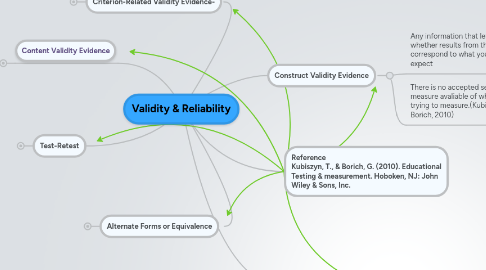
1. Content Validity Evidence
1.1. Answers the question "Does the test measure instructional objectives?"
1.2. Established by inspecting test questions to see whether they correspond to what the user decides shouls be on the test
2. Criterion-Related Validity Evidence-
2.1. When scores from a test are correalated with an external criterion
2.2. Two types Concurrent & Predictive
2.2.1. Concurrent criterion-related validity- Deals with measures that can be administered at the same time as the measure to be validated
2.2.1.1. Determined by adminstering both the new test and the established test to group the respondents, then finding the correlation between the two sets of test scores. (Kubiszyn & Borich, 2010)
2.2.2. Predicitive validity evidence- Referes to how well the test pridicts some future behavior of the examinees
2.2.2.1. Determined by adminstering the test to a group of subjects, then measuring the subjects on whatever the test is supposed to predict after a period of time has elapsed (Kubiszyn & Borich, 2010)
3. Test-Retest
3.1. Test is givn twice and the correlation betweenthe first test and th second set of scores are determined
4. Alternate Forms or Equivalence
4.1. Both forms of test are adminstered to students and the correlation between the two set of scores is determined
4.2. Eliminates the problem of memory and practice in the test-retest estimates
5. Construct Validity Evidence
5.1. Any information that lets you know whether results from the test correspond to what you would expect
5.2. There is no accepted second measure avaliable of what you're trying to measure.(Kubiszyn & Borich, 2010)
6. Internal Consistency
6.1. Split Halves
6.1.1. Involves splitting the test into two equivalent halves and determining the correlation between
6.1.1.1. assign first half of test to one form and all items in the second half of the test to another form.(Kubiszyn & Borich, 2010)
6.2. Kuder-Richardson Method
6.2.1. Measures the extent to which items within one form of the test have as much in common with one another. (Kubiszyn & Borich, 2010)
